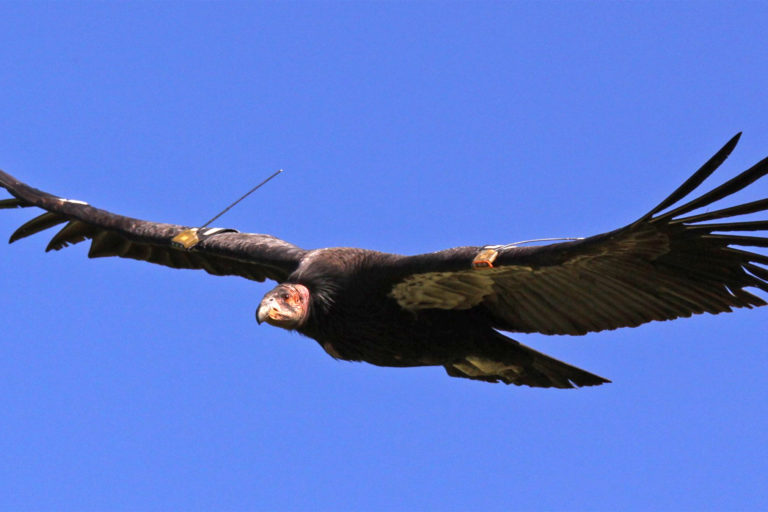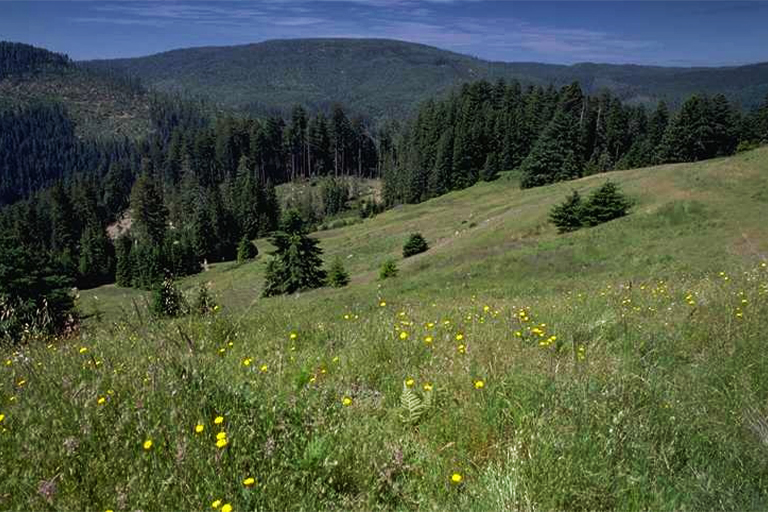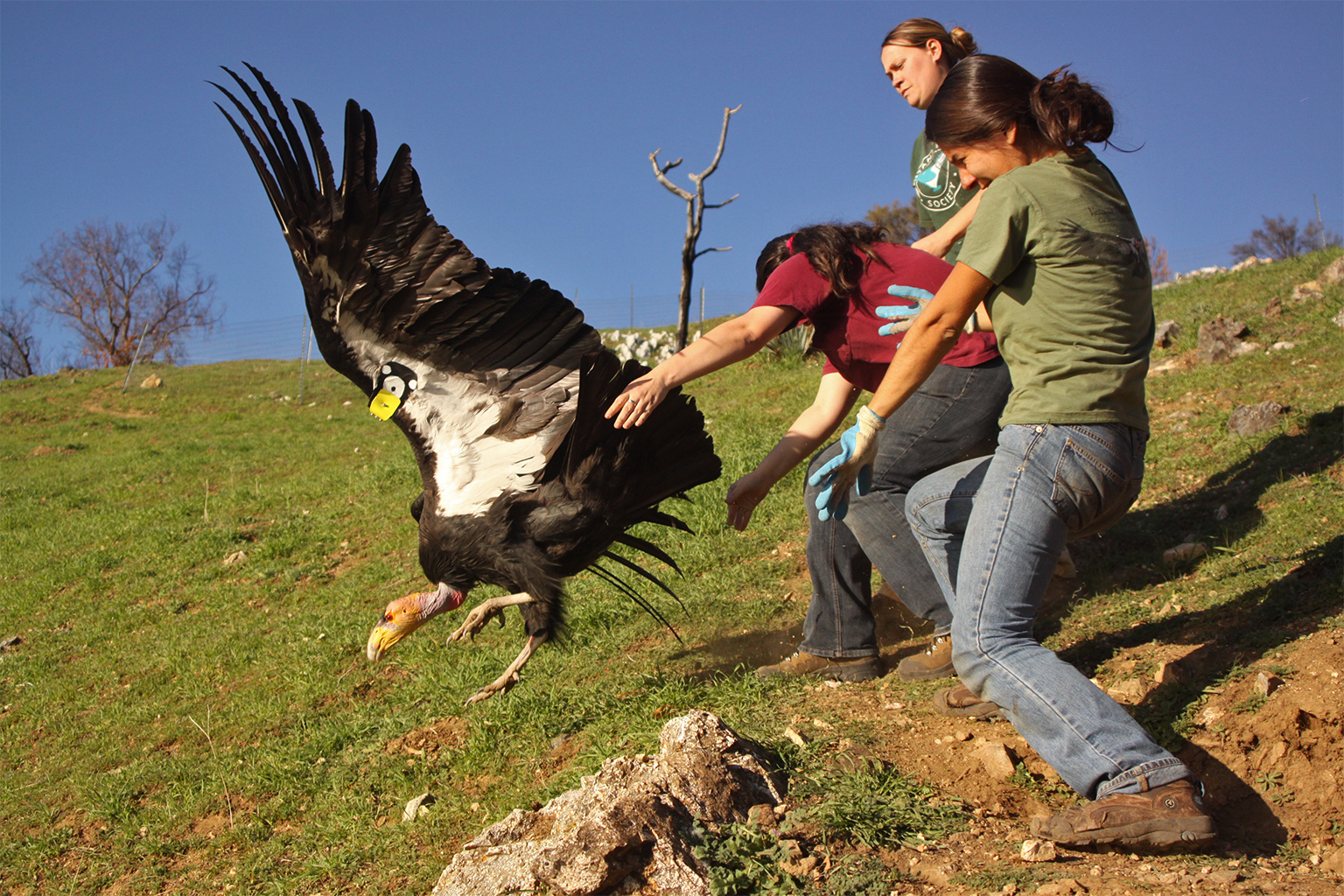
- The California condor is a creature of great cultural significance to the Yurok Tribe in what is now Northern California, but was wiped out from their ancestral territory by the early 20th century.
- Tribal elders made the decision to bring the bird back in 2003, kicking off years of research and outreach to pave the way for this critically endangered species’ return.
- This spring, the U.S. Fish and Wildlife Service finally gave the green light for a population of California conders to be reestablished in the Pacific Northwest; the first four will be released next spring.
Next spring, California condors will soar in northern California for the first time in a century. Four young condors will be released in Redwood National and State Parks, reintroducing this critically endangered species to what was once only the middle of a vast range that stretched from Baja California all the way up to British Columbia. But if it weren’t for the Yurok Tribe, who have fought for the return of this culturally and ecologically important bird for the past 13 years, the condor’s Pacific Northwest homecoming might never have happened at all.
The story of the California condor’s (Gymnogyps californianus) return to the Pacific Northwest is one of endurance, said Thomas Gates, who worked as the director of the tribe’s Office of Self-Governance at the time tribal elders decided to prioritize condor reintroduction.
When the tribe first stated their desire to bring the condor back to northern California, “people thought we were crazy,” Gates said. It took years of research, relationship building, and careful planning to get the official go-ahead from the U.S. Fish and Wildlife Service (USFWS) to establish a new population of condors that might fly as far north as Oregon.
The USFWS backed the project in March of this year.
“I’m really excited to be a tribal member helping to lead this tribal endeavor, because honestly tribes don’t get to do this sort of thing as often as I’d like,” said Tiana Williams-Claussen, who is the director of the Yurok Tribe Wildlife Department and has played an integral role in the reintroduction effort.
The Yurok’s full ability to care for their land was taken away when they were forced onto a reservation, she said. “This is an example of a way that tribes are taking that authority and that power back.”


The importance of the condor
The California condor (known as prey-gon-eesh in the Yurok language) is a species of particularly high cultural importance to the Yurok Tribe, Williams-Claussen said. Tribal members tell stories about the condor that go back to the beginning of time, and collect condor feathers to use in regalia for their biennial World Renewal Ceremonies. The bird is also believed to carry prayers to the heavens due to its ability to fly to dizzying heights of up to 4,500 meters (15,000 feet).
But Williams-Claussen didn’t grow up hearing stories about the condor, she said. By the early 20th century, the last condors in the Pacific Northwest had disappeared, and the Yurok Tribe’s cultural traditions were slipping away as well.
“There was a time when it was considered harmful to tell these stories, and dangerous because of the massacres and boarding school experience,” Williams-Claussen said.
But during her lifetime, the tribe began to push for a rejuvenation of Yurok cultural traditions, and they turned to their aging elders.
“I think we often consider those closest to precontact to have held the most knowledge, unmodified by American culture, and they may have wanted to capture that generation’s knowledge before it was lost,” she said, adding that there has been an “exponential growth” in cultural learning opportunities over the course of her life.
But tribal elders wanted to go a step further and bring back an animal with an integral role in their traditions: the condor.
“The condor was the top bird in the ceremonial hierarchy,” Gates said. “There was this idea that without that bird back in this environment, the Yurok world was out of balance.”

The long road to reintroduction
In 2003, Yurok tribal elders decided to bring the condor home. But first, they needed the acceptance of the USFWS, which was initially unreceptive to the idea. The California condor nearly went extinct in the 1980s, with a wild population of just 23 individuals at one point. Thanks to captive-breeding efforts and Endangered Species Act protections, there are now about 300 wild condors, but their position remains precarious.
Initially, the USFWS argued that the condor was too precious to risk experimenting with at a new site, Gates said. Some biologists even said the condor had never lived in northern California at all.
But the tribe didn’t give up. In 2008, they secured funding through the tribal wildlife grant program to form a wildlife department. Williams-Claussen was the department’s first official employee. Soon after, they brought in an expert on condor reintroduction named Chris West, who now leads the tribe’s condor reintroduction program.
West first heard about the effort when he was having lunch with the coordinator of the condor program in Southern California, who told him bluntly, “There’s this tribe, and they keep harassing me about condors,” he said.
When West went to talk to the Yurok Tribe, he saw that they had a lot of valuable cultural information about where condors used to fly and what they would feed on.
“It kind of opened my eyes, in a lot of ways,” he said.

When West began to learn more about the California condor’s historic range, he saw that it actually extended as far north as British Columbia, placing northern California squarely in the middle of where the birds once soared.
“I started to think, well, it does make a lot of sense to bring condors back to a larger area,” West said.
But the USFWS didn’t get behind the idea until 2013. Given the ongoing threat of lead poisoning throughout the condor’s range and the relatively small number of release sites, they began to realize that “we have too few eggs in too few baskets,” West said. “I think that was a really important turning point.”
Once the USFWS was persuaded to pursue the effort, Williams-Claussen, West, and their partners had to gather data to see if a population of California condors could survive in a place where they hadn’t been seen in a century. They worked tirelessly for the next eight years to gather the evidence required, partnering with Redwood National and State Parks.

“The Yurok Tribe has been such a catalyst and did so much of the groundwork of support for this idea,” said Dave Roemer, the superintendent of Redwood National and State Parks. “All I had to do was recognize that it was time to help.”
The team studied lead levels in the area’s turkey vultures (Cathartes aura) and common ravens (Corvus corax) and ran extensive outreach campaigns to educate hunters on the benefits of switching from lead to copper bullets, which are not harmful when ingested by condors. They also analyzed marine mammal blubber for traces of the banned pesticide DDT, since condors might feast on whale carcasses. Finally, they identified suitable release sites and traveled to cities around the Pacific Northwest to hold public hearings and address questions and concerns from the public.
After exhaustive efforts, they wound up with a memorandum of understanding signed by 16 different partners across the private and public sectors, all saying “Yes, this would be a good move for condors and a good move for the region,” Williams-Claussen said.
The process culminated in March of this year, when the tribe received the green light to build a release pen for its initial batch of condors. While they were hoping to initiate the release this year, material shortages due to the pandemic slowed the process, but didn’t stop it. In an undisclosed clearing in the national park’s Bald Hills area, work is well underway to welcome the condors home.

The release site is elevated, with open space to provide a “runway” for takeoff, and old-growth redwoods nearby for roosting.
“Once they get aloft, they’ll see mountains, they’ll see the coast … we’re hoping it’s a condor paradise,” Roemer said. “The largest-wingspan bird in the tallest trees is a beautiful vision.”
Williams-Claussen said she’s happy to see something that was a dream for so long finally becoming reality.
“I want to express how honored and happy I am to be part of this story,” she said. “I’ve realized my dream as a Yurok woman to come back and serve my tribe in a way that is really going to make an impact on our youth — on my daughter and the children to come.”
Banner image: A released California condor with a wing transmitter soars in the sky. Image courtesy of Chris West.
Thanks to the Yurok Tribe, condors will return to the Pacific Northwest
Source: Trends News

0 Comments